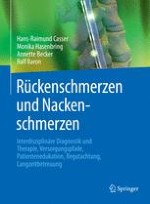
2016 | OriginalPaper | Buchkapitel
1. Vom akuten zum chronischen Schmerz
verfasst von : A.-R. Fahland, Dipl. Psych., Prof. Dr. T. Kohlmann, PD Dr. C.O. Schmidt
Erschienen in: Rückenschmerzen und Nackenschmerzen
Verlag: Springer Berlin Heidelberg

2016 | OriginalPaper | Buchkapitel
verfasst von : A.-R. Fahland, Dipl. Psych., Prof. Dr. T. Kohlmann, PD Dr. C.O. Schmidt
Erschienen in: Rückenschmerzen und Nackenschmerzen
Verlag: Springer Berlin Heidelberg